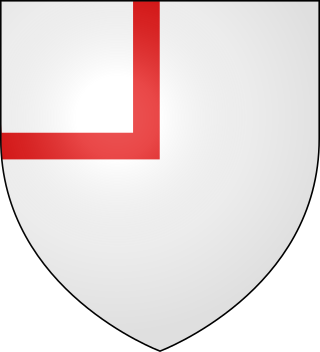
Pierre Athanase Larousse was a French grammarian, lexicographer and encyclopaedist. He published many of the outstanding educational and reference works of 19th-century France, including the 15-volume Grand dictionnaire universel du XIXe siècle.

Biéville-Beuville is a commune in the Calvados department in the Normandy region in northwestern France. The hyphenated name originates from the former communes of Biéville-sur-Orne and Beuville, which were united in 1972.

Gérard Gilles Marie Armand Larrousse is a former sports car racing, rallying and Formula One driver from France. His greatest success as a driver was winning the 24 Hours of Le Mans in 1973 and 1974, driving a Matra-Simca MS670. After the end of his career as racing car driver, he continued to be involved in Formula One as a team manager for Renault. He later founded and ran his own Formula One team, Larrousse, from 1987 to 1994.

The Grand dictionnaire universel du XIXe siècle, often called the Grand Larousse du dix-neuvième, is a French encyclopedic dictionary. It was planned, directed, published, and to a substantial degree written by Pierre Larousse, though he also relied on anonymous fellow contributors and though he died in 1875, before its completion. The publication of the Grand dictionnaire universel in 15 volumes of 1500 pages extended from 1866 to 1876. Two supplements were published in 1877 and 1890.
Following the work of Pierre Larousse on the Grand dictionnaire Universel, the Grand Dictionnaire Encyclopédique Larousse, a ten-volume dictionary, was published in Paris between 1982 and 1985 by Éditions Larousse. It is an encyclopedia and a dictionary merged in a single alphabetical listing. Beneath the standard dictionary entry comes the encyclopedic section.
An apocrisiarius, the Latinized form of apokrisiarios, sometimes Anglicized as apocrisiary, was a high diplomatic representative during Late Antiquity and the early Middle Ages. The corresponding (purist) Latin term was responsalis. The title was used by Byzantine ambassadors, as well as by the representatives of bishops to the secular authorities. The closest modern equivalent is a papal nuncio; the title apocrisiarius is also still employed by the Anglican Church.

Le Petit Larousse Illustré, commonly known simply as Le Petit Larousse, is a French-language encyclopedic dictionary published by Éditions Larousse. It first appeared in 1905 and was edited by Claude Augé, following Augé's Dictionnaire complet illustré (1889). The one-volume work has two main sections: a dictionary featuring common words and an encyclopedia of proper nouns. Le Petit Larousse 2007 includes 150,000 definitions and 5,000 illustrations. A Spanish-version El Pequeño Larousse Ilustrado and an Italian version Il Piccolo Rizzoli Larousse have also been published.
The Grand Larousse encyclopédique en dix volumes is a French encyclopedic dictionary published by Larousse between February 1960 and August 1964, with two later supplements that update the content to 1975.
Moritz Adolf Schlesinger, generally known during his French career as Maurice Schlesinger, was a German music editor. He is perhaps best remembered for inspiring the character of M. Arnoux in Gustave Flaubert's novel Sentimental Education.
Éditions Robert Laffont is a book publishing company in France founded in 1941 by Robert Laffont (1916–2010). Its publications are distributed in almost all francophone countries, but mainly in France, Canada and in Belgium.
Dictionnaire Bouillet is the informal title of the Dictionnaire universel d'histoire et de géographie, a French reference work in the public domain. The first edition was published in 1842; the 34th and final edition was published in 1914. The original authors were Marie-Nicolas Bouillet and Alexis Chassang (1827–78).

Éditions Larousse is a French publishing house specialising in reference works such as dictionaries. It was founded by Pierre Larousse and its best-known work is the Petit Larousse.
Jean Sage was the sporting director at the French Formula One team Renault between 1977 and 1985.
The Papyrus Larousse Britannica is a Greek language encyclopedia of 61 volumes, based on the French encyclopedia Grand Larousse encyclopédique and the English Encyclopædia Britannica.
The Église gallicane, or the Gallican Church, was a French Christian denomination founded by a former Roman Catholic priest, Hyacinthe Loyson. Loyson was considered to be the most effective pulpit orator of his day. In 1868, he was summoned to Rome and was ordered to stop preaching on any controversial subject, and to confine himself exclusively to those subjects upon which all Roman Catholics were united in belief.

The Nouveau Larousse illustré was an illustrated French language encyclopedia published by Éditions Larousse between 1897 and 1904, in 7 volumes and a supplement. It was essentially a scaled-down version of the Grand dictionnaire universel du XIXe siècle of Pierre Larousse, but updated and written in a more neutral, scientific style under the editorship of Claude Augé (1854−1924).

General of Division François Antoine Teste, Baron Teste was a French officer during the Napoleonic Wars. He was in the French Chamber of Peers from 1839 to 1848.

Lucien Moreau was a French journalist, monarchist and member of the Action Française.

Esquarre is a name for both a heraldic ordinary and a set of related mobile charges. As an ordinary, the Esquarre is defined as a charge that borders a quarter on its two interior edges abutting the field. The Esquarre isolates the quarter from the rest of the field. De Galway suggested that the Esquarre is employed when both quarter and field are the same tincture. The shape of the ordinary is likened to a carpenter's square, a tool formed of two arms joined perpendicularly. When the two arms are of unequal length, the term potence (Fr.) is also used, a term likening the form of this variant to a joined post and crossbeam, or gallows/scaffold.









